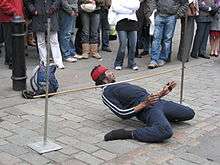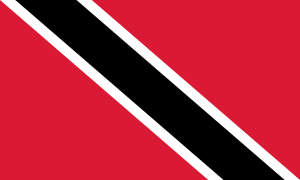Limbo (dance)

Limbo is a traditional popular dance contest that originated on the island of Trinidad. The dance originated as an event that took place at wakes in Trinidad and Tobago, and was popularized by dance pioneer Julia Edwards[1] (known as the First Lady of Limbo) and her company which appeared in several films, in particular Fire Down Below (1957), and toured widely in the Caribbean, Europe, North America, South America, Asia, and Africa in the 1960s and later. The film Julia and Joyce (2010) by Trinidadian/American dance researcher/choreographer Sonja Dumas features the evolution of the Limbo and the contribution of Julia Edwards to the explosion of its popularity.
Rules
A horizontal bar, known as the limbo bar, is placed atop two vertical bars. All contestants must attempt to go under the bar with their backs facing the floor. Whoever knocks the bar off or falls is eliminated from the contest. After everyone has completed their turns, the bar is lowered slightly and the contest continues. The contest ends when only one person can successfully "limbo" under the bar.
Popularization by Chubby Checker
Traditionally, the limbo dance began at the lowest possible bar height and the bar was gradually raised, signifying an emergence from death into life. In its adaptation to the world of entertainment, troupes began reversing the traditional order. Julia Edwards added a number of features that are now considered standard, such as human 'bars' formed by the limbs of other dancers, and the use of fire in the performance of limbo. Limbo dancers generally move and respond to a number of specific Afro-Caribbean drum patterns. As Limbo gained popularity as a tourist activity and a form of entertainment, pop music began using Caribbean rhythms to respond to the emerging craze in the United States. One major example is the song "Limbo Rock" (recorded by Chubby Checker), which became a number 2 charted hit on the Billboard Top 100, from which emerged the popular quote/chant that is associated with limbo which Checker also helped to popularize: "How low can you go?" Limbo was brought into the mainstream by Trinidadian Calypsonian Brigo (Samuel Abrahams) with his popular Soca song "Limbo Break".
Limbo is unofficially considered the national dance of Trinidad and Tobago, which refers to itself as the land of limbo, steelpan (steel drums), and calypso. After a preparatory dance, the dancer prepares and addresses the bar, lowering and leaning back their body while balancing on feet akimbo with knees extended backwards. The dancer is declared "out" and loses the contest if any part of the body touches the stick or pole that they are passing beneath, or if the hands touch the floor. When several dancers compete, they go under the stick in single-file; the stick is gradually lowered until only one dancer, who has not touched either the pole or the floor, remains.
As Limbo spread out of Trinidad and Tobago to the wider world and the big screen, in several other Caribbean islands, such as Barbados and Jamaica, limbo became a major part of the tourism package. Indeed, in Jamaica, the trendy limbo music of the 1950s was often based on a clave rhythm. It is also widely heard in Jamaican mento recorded in the 1950s, in songs such as "Limbo" by Lord Tickler and Calypsonians or "Limbo" by Denzil Laing & the Wrigglers, as well as many other songs not directly related to the limbo dance theme. Limbo is still practiced and presented by numerous dance troupes in the context of the Prime Minister's Best Village Competition and during the Carnival season in Trinidad and Tobago.
In touristic presentations, professional limbo dancers often invite spectators to participate after their presentation. The massive popularity of limbo emerges directly from this audience participation. In recent years, limbo dancing has been conducted as a social "icebreaker" game for tourists at Caribbean and other tropical resorts. The winning dancer often receives a prize.
The name comes directly from the Trinidad dialect of English; Merriam–Webster lists the etymology as "English of Trinidad & Barbados; akin to Jamaican English limba to bend, from English limber".[2]
History
The word 'limbo' dates back to the 1950s. It is conjectured that limbo is a West Indian English derivative of 'limber'. Limber is a sixteenth-century word used in the dialectical sense to refer to a cart shaft, alluding to its to and fro motion:
"Consistent with certain African beliefs, the dance reflects the whole cycle of life....The dancers move under a pole that is gradually lowered from chest level, and they emerge on the other side, as their heads clear the pole, as in the triumph of life over death".[3]
This dance is also used as a funeral dance and may be related to the African legba or legua dance.[4]
The limbo dates back to the mid to late 1800s in Trinidad. It achieved mainstream popularity during the 1950s. An alternative explanation of the name is suggested; that the version of the limbo performed in nineteenth century Trinidad was meant to symbolize slaves entering the galleys of a slave ship, or a spirit crossing over into the afterworld, or "limbo", but no literary reference is known to substantiate this linkage.
World record
The world record for lowest limbo dance is held by Shemika Charles, an 18-year-old woman from Trinidad who lived in New York City. On 16 September 2010, she successfully danced under a bar only 8.5 inches (21.5 cm) above the ground.[5]
References
- ↑ Emrit, Ronald C. "Julia Edwards". www.bestoftrinidad.com. Retrieved 2015-04-29.
- ↑ "Limbo | Definition of Limbo by Merriam-Webster". M-w.com. Retrieved 2016-06-02.
- ↑ Stanley-Niaah, Sonjah. "Mapping of Black Atlantic Performance Geographies: From Slave Ship to Ghetto." In Black Geographies and the Politics of Place, ed. by Katherine McKittrick and Clyde Woods, 193-217. Cambridge, MA: South End Press, 2007.
- ↑ Limbo Dance. Retrieved from http://www.tntisland.com/limbo.html.
- ↑ "Lowest limbo by a woman - world record set by Shemika Charles". Worldrecordsacademy.org. 2010-09-23. Retrieved 2016-06-02.
| Wikimedia Commons has media related to Limbo (dance). |
